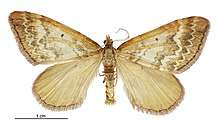Asaphodes helias
Asaphodes helias is a species of moth in the family Geometridae. It is endemic to New Zealand. It has been found in Canterbury, Otago and Southland.
| Asaphodes helias | |
|---|---|
 | |
| Male | |
| Scientific classification | |
| Kingdom: | Animalia |
| Phylum: | Arthropoda |
| Class: | Insecta |
| Order: | Lepidoptera |
| Family: | Geometridae |
| Genus: | Asaphodes |
| Species: | A. helias |
| Binomial name | |
| Asaphodes helias | |
| Synonyms[2] | |
| |
Taxonomy
This species was described by Edward Meyrick in 1883 as Larentia helias using material he collected in Dunedin.[2][3] George Hudson discussed and illustrated this species as Xanthorhoe helias in 1898.[4] Hudson also discussed and illustrated the species in his 1928 publication The Butterflies and Moths of New Zealand.[5] In 1971 John S. Dugdale placed this species within the genus Asaphodes.[6] The type specimen is held at the Natural History Museum, London.[2]
Description
Hudson described the species as follows:
The expansion of the wings is 1 inch. All the wings are pale ochreous ; the fore-wings have a slender brown transverse line at the base, then a large loop-like marking from the costa, almost meeting a smaller, similarly looped marking from the dorsum ; next a broad irregular dark brown band a little beyond the middle, considerably indented towards the termen ; this is followed by a rather narrow pale band, and then by a narrow brown band, also indented towards the termen ; there is a small oblique brown mark below the apex, and a terminal series of black dots. The hind-wings have several faint dusky transverse lines near the base, a row of small spots near the termen, and a terminal series of minute black dots. The cilia of all the wings are reddish-ochreous.[4]
Distribution
This species is endemic to New Zealand.[1][7] As well as the type locality of Dunedin, the species has been found in the Dansey Ecological district and the Nevis Red Tussock Fen in Otago.[8][9] This species has also been found near the Hooker traffic bridge close to Mount Franklin in Canterbury.[10]
Habitat and host plant
This moth has been observed as frequenting tussock and scrubby areas that have the fern Polystichum vestitum present.[10] The larvae of A. helias have been reared in captivity on forest herbs including Cardamine and Ranunculus species.[11] Larvae have also been found feeding from species within these genera in the wild.[11] The larvae of A. helias have also adapted to feeding on an exotic buttercup.[11]
References
| Wikimedia Commons has media related to Asaphodes helias. |
- "Asaphodes helias (Meyrick, 1883)". www.nzor.org.nz. Landcare Research New Zealand Ltd. Retrieved 22 August 2018.
- Dugdale, J. S. (1988). "Lepidoptera - annotated catalogue, and keys to family-group taxa" (PDF). Fauna of New Zealand. 14: 173. Retrieved 22 August 2018.
- Meyrick, Edward (1883). "Monograph of New Zealand Geometrina [abstract]". New Zealand Journal of Science. 1883: 526–531 – via Biodiversity Heritage Library.
- Hudson, G. V. (1898). New Zealand moths and butterflies (Macro-lepidoptera). London: West, Newman & Co. pp. 64–65. doi:10.5962/bhl.title.32466. OCLC 727236768. Retrieved 24 August 2018.
- Hudson, G. V. (1928). The Butterflies and Moths of New Zealand. Wellington: Ferguson & Osborn Ltd. p. 120. OCLC 25449322.
- Dugdale, J. S. (1971). "Entomology of the Aucklands and other islands south of New Zealand: Lepidoptera, excluding non-crambine Pyralidae". Pacific Insects Monograph. 27: 55–172.
- Gordon, Dennis P., ed. (2010). New Zealand Inventory of Biodiversity, Volume Two, Kingdom Animalia: Chaetognatha, Ecdysozoa, Ichnofossils. Vol. 2. Christchurch, N.Z.: Canterbury University Press. p. 459. ISBN 9781877257933. OCLC 973607714.
- Patrick, B. H. (1991). Insects of the Dansey ecological district (PDF). Wellington, N.Z.: Department of Conservation, New Zealand. ISBN 978-0-478-01285-9. Retrieved 25 August 2018.
- "Nevis Red Tussock Fen". www.orc.govt.nz. 28 September 2017. Retrieved 25 August 2018.
- Philpott, Alfred (1930). "The Lepidoptera of Mount Cook District, with Descriptions of New Species". Transactions and Proceedings of the Royal Society of New Zealand. 61: 419–439.
- Patrick, Brian (April 2000). Conservation status of two rare New Zealand geometrid moths (PDF). Science for Conservation. 145. pp. 1–21. ISBN 978-0478219463. ISSN 1173-2946.